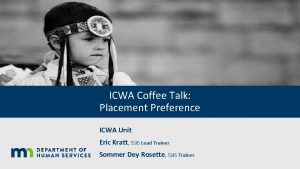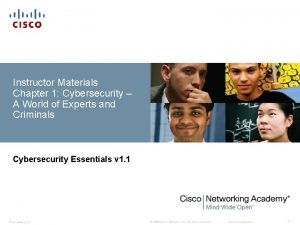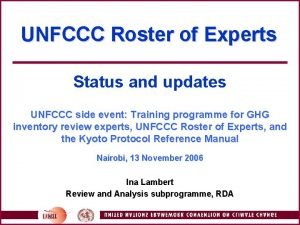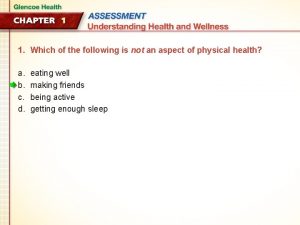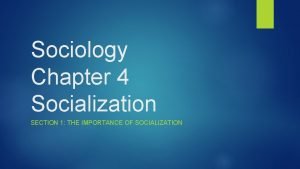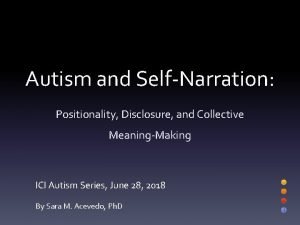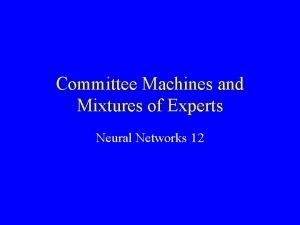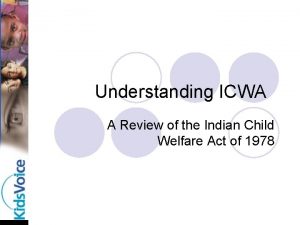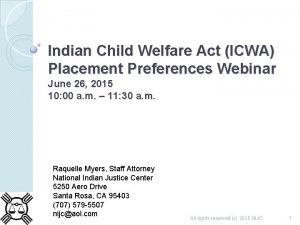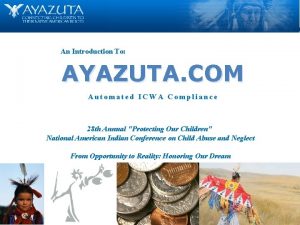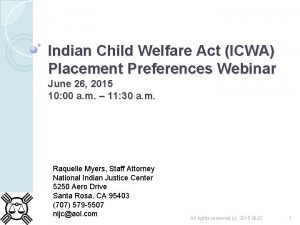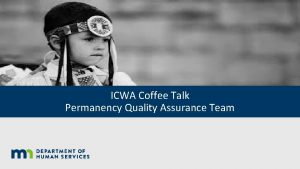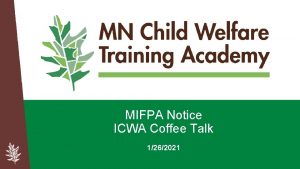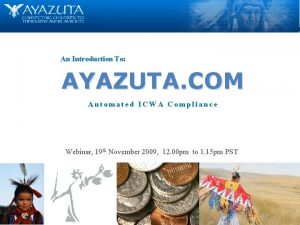OREGON ICWA Q AND A ASK THE EXPERTS




















- Slides: 20

OREGON ICWA Q AND A: ASK THE EXPERTS, PART 1 I Hon. Morgan Long Adrian (Addie) Smith Lea Ann Easton Kristy Barrett Shannon Dennison March 15, 2021

STANDARD OF PROOF • • Imminent physical damage or harm to the child • Protective custody • Shelter: preponderance The Indian child’s continued custody by the child’s parent or custody by the child’s Indian custodian is likely to result in serious emotional or physical damage to the Indian child • Adjudication: clear and convincing competent evidence • Guardianship (419 B. 365): beyond a reasonable doubt • Guardianship (419 B. 366): clear and convincing competent evidence • Termination of parental rights: beyond a reasonable doubt • Must show a causal relationship between the particular conditions in the Indian child’s home and the likelihood that the Indian child’s continued custody by the child’s parent • Sufficient progress to make it possible for Indian child to safely return • Permanency hearing: clear and convincing (Sections throughout)

• Emergency inquiry. PROTECTI VE CUSTODY ORDER ORS 419 B. 150 • ODHS must make a good faith effort to determine whether the child is an Indian child and to contact the tribe to determine the child’s affiliation. Section 15(1) • Emergency notice. • If there is “reason to know” child is Indian child, and the nature of the emergency allows, ODHS must notify the tribe of the basis for the child’s removal, the time, date and place of the initial hearing, and a statement regarding the tribe’s right to participate in the proceeding as a party. Section 16(1) • If ORICWA applies, no basis for PCO except to prevent imminent physical damage or harm to child.

• Is there “reason to know” child is an Indian child? • Has notice been provided? • Has counsel been appointed? • Has ODHS provided active efforts to prevent removal? SHELTER HEARING ORS 419 B. 185 • Is removal necessary and the least restrictive means available to prevent imminent physical damage or harm to the child? • Is removal in the child’s best interest (consistent with Section 5)? • Is the child placed in accordance with the placement preferences? • If court places child in care, the order must direct ODHS to immediately notify court if new information indicates that the emergency has changed. Upon receiving such a notice, the court shall promptly hold a new hearing to determine whether out of home care is still necessary. • An emergency placement must terminate immediately when it is no longer necessary to prevent imminent physical damage or harm to the child. 25 CFR § 23. 113.

• Protective custody may not be continued for more than 30 days unless: • The court determines that a return home would subject the child to imminent physical damage or harm; • Despite diligent efforts, has been unable to transfer the proceeding to Tribal Court; AND • Has been unable to set the jurisdictional hearing for a reason other than scheduling or availability of counsel and the reason has been documented in writing on the record. ORS 419 B. 185(3)(d); 25 CFR § 23. 113(e) SHELTER HEARING ORS 419 B. 185

TRANSFER TO TRIBAL COURT • Court shall transfer to tribal court, at any time, if parent, Indian custodian, or tribe requests, unless • Tribe declines • Parent objects (unless terminated/re-requested after death of objecting parent) • Any party successfully proves by C&C that there is good cause to NOT transfer: • Court cannot consider • Late stage of case; potential change of placement; previous proceeding where transfer was not requested; negative perceptions of the tribes court or social service program; BIC (Section 13)

SETTLEMENT OF PETITION • Prior to scheduling a settlement conference on jurisdiction, guardianship, or termination of parental rights: • Notice to tribe: the court must provide notice to the child’s tribe that includes: • a description of the settlement process, • the procedure to schedule the settlement conference and • the date the hearing will occur if settlement is not reached. • Before taking an admission, notice to the tribe, parents, Indian custodian (if applicable) and BIA (in some circumstances) under Section 16(2) must be filed with the court.

• If the court found protective custody was necessary to prevent imminent physical damage or harm to the child, the court shall hold a jurisdictional hearing within 30 days unless: • The parent, Indian custody or tribe has requested an extension of time; JURISDICTIO N TIMING ORS 419 B. 305 • The child has been returned to the parent, or the court orders the child be returned to the parent; • The court has continued the protective custody order beyond the 30 day period because: • A return home would subject the child to imminent physical damage or harm; • Despite diligent efforts, the court has been unable to transfer the proceeding to Tribal court; and • The court has been unable to set the case for a hearing for a reason other than scheduling or availability of counsel and the reason has been document in writing on the record. • ORS 419 B. 305(2); 25 CFR § 23. 113(e)

• State court versus Tribal court jurisdiction • Compliant notice filed with the court? Section 16(2) • Sent to each tribe, parents, Indian custodian (if applicable) and BIA (if necessary) • Qualified expert witness. Section 17 • Standard of proof: clear and convincing • ORICWA/ICWA standard: • Is the parents’ continued custody of the child likely to result in serious emotional or physical damage to the child? • The evidence must show a causal relationship between the particular conditions in the child’s home & the likelihood that custody or continued custody of the child will result in serious emotional or physical damage to the particular child who is the subject of the proceeding. Evidence that shows the existence of community or family poverty, isolation, single parenthood, custodian age, crowded or inadequate housing, substance abuse or nonconforming social behavior does not, by itself, establish a causal relationship. JURISDICTIO N ORS 419 B. 305

• Has ODHS made active efforts to reunify the family? • Include description in judgment. • No aggravated circumstances finding in ICWA/ORICWA DISPOSITION ORS 419 B. 310 • Is the child placed in accordance with the placement preferences? • If not, is a party seeking a good cause exception? • Is it an improper placement that must be reviewed under Section 22?

• Active efforts to reunify: • Finding required even after concurrent plan implemented. • If court finds no active efforts: • Court must determine period of time it was not provided and order ODHS to provide the services necessary for active efforts; REVIEW ORS 419 B. 449 • Court must order: • the child returned home, unless the court finds returning the child will result in substantial and immediate danger or threat of danger to the Indian child; • The placement preferences be followed; and • ODHS continue to foster relationships with long term placement resources meeting the placement preferences. • If the child is placed at home and the court determines the child should be removed, court must make the inquiry, notice and finding required under ORS 419 B. 305 and 419 B. 310.

• PERMANENC Y ORS 419 B. 476 • Change of plan from reunification - new findings, by clear and convincing evidence (ORS 419 B. 476(5)(j)): • Active efforts were provided to make it possible for the child to safely return home; • Continued removal is necessary to prevent serious emotional or physical damage to the child; • The parent has not made sufficient progress to make it possible for the child to safely return home; and • The new permanency plan complies with the placement preferences. Court finding of no active efforts to return home (ORS 419 B. 476(7): • The court may not, at that permanency hearing, change the permanency plan to something other than to reunify the family. • The court may not set a date for a subsequent permanency hearing until the department has provided active efforts for the number of days that active efforts were not previously provided, except as otherwise required by ORS 419 B. 470.

The court may grant the guardianship of the Indian child only: DURABLE GUARDIANSHI P ORS 419 B. 365 • If the court has offered the parties the opportunity to participate in mediation; • If requested by the tribe, an agreement is in place that requires the proposed guardian to maintain connection between the Indian child and the Indian child’s tribe; and • If after inquiry …& notice & in addition to any other findings required for TPR, the court finds: • By clear and convincing evidence, including QEW testimony, that the Indian child’s continued custody by the child’s parent or custody by the child’s Indian custodian is likely to result in serious emotional or physical damage to the Indian child; • That active efforts to reunite the family did not eliminate the necessity for guardianship based on serious emotional or physical damage to the Indian child; and • That the placement complies with the placement preferences. The evidence must show a causal relationship between the particular conditions in the child’s home & the likelihood that custody or continued custody of the child will result in serious emotional or physical damage to the particular child who is the subject of the proceeding. Evidence that shows the existence of community or family poverty, isolation, single parenthood, custodian age, crowded or inadequate housing, substance abuse or nonconforming social behavior does not, by itself, establish a causal relationship.

The court may grant the permanent guardianship of the Indian child only: PERMANENT GUARDIANSHI P ORS 419 B. 366 • If the court has offered the parties the opportunity to participate in mediation; • If requested by the tribe, an agreement is in place that requires the proposed guardian to maintain connection between the Indian child and the Indian child’s tribe; and • If after inquiry …& notice & in addition to any other findings required for TPR, the court finds: • Beyond a reasonable doubt, including QEW testimony, that the Indian child’s continued custody by the child’s parent or custody by the child’s Indian custodian is likely to result in serious emotional or physical damage to the Indian child; • That active efforts to reunite the family did not eliminate the necessity for permanent guardianship based on serious emotional or physical damage to the Indian child; and • The placement complies with the placement preferences. The evidence must show a causal relationship between the particular conditions in the child’s home & the likelihood that custody or continued custody of the child will result in serious emotional or physical damage to the particular child who is the subject of the proceeding. Evidence that shows the existence of community or family poverty, isolation, single parenthood, custodian age, crowded or inadequate housing, substance abuse or nonconforming social behavior does not, by itself, establish a causal relationship.

The court may grant TPR if: TERMINATIO N OF PARENTAL RIGHTS ORS 419 B. 500 • The court has offered the parties the opportunity to participate in mediation; • If requested by the tribe, an agreement is in place that requires the proposed adoptive resource to maintain connection between the Indian child and the Indian child’s tribe; and • After inquiry, notice & in addition to any other findings required for TPR, the court finds: • Beyond a reasonable doubt, including QEW testimony, that the Indian child’s continued custody by the child’s parent or custody by the child’s Indian custodian is likely to result in serious emotional or physical damage to the Indian child; • That active efforts to reunite the family did not eliminate the necessity for TPR based on serious emotional or physical damage to the Indian child; and • The placement complies with the placement preferences. The evidence must show a causal relationship between the particular conditions in the child’s home & the likelihood that custody or continued custody of the child will result in serious emotional or physical damage to the particular child who is the subject of the proceeding. Evidence that shows the existence of community or family poverty, isolation, single parenthood, custodian age, crowded or inadequate housing, substance abuse or nonconforming social behavior does not, by itself, establish a causal relationship.

• Incorporates new requirements for petitionless adoption when ORICWA applies: • DHS must offer to coordinate mediation between tribe and adoptive placement; ADOPTION ORS 419 B. 529 • If requested by tribe, an agreement is in place that requires the proposed adoptive parent to maintain connection between the child and tribe; and • If a continuing contact agreement is in place, ODHS incorporates the terms in the placement report. • If the tribe and the adoptive placement enter into a continuing contact agreement, the judgment of adoption must include the terms of the agreement.

• Placement outside of the preferences: PLACEMENT OUTSIDE OF PREFERENCE S • If any party asserts or the court has reason to believe the child is placed outside of the preferences, the court must make a determination regarding the placement under Section 22. • Court shall invalidate the placement if the court determines Section 23 was violated; the proceeding must be vacated and the court shall order the child immediately returned to the parent or Indian custodian. Section 22(2).

• A petition to invalidate the placement, guardianship, or TPR involving an Indian child may be filed in any court of competent jurisdiction by the child, parent or Indian custodian or tribe. IMPROPER PLACEMENT GUARDIANSHI P OR TPR • The court shall invalidate the placement, guardianship, or TPR if it finds a violation of section: • 12 (jurisdiction), 13 (motion to transfer), 16(2), 3(a) or (b), (5)(a) (notice and waiting periods), 17(2) (QEW testimony), 18 (active efforts), 20(1) (child and parent’s right to counsel), 21 (right to examine documents), 23 (placement preferences) • The proceeding that led to the violation must be vacated &, if the proceeding led to the removal or placement of the Indian child, the court shall order the child immediately returned to the parent or Indian custodian, and any issues determined must be relitigated.

IMPROPER RETENTIO N OR REMOVAL OF CHILD • If any party to a proceeding under ORS 419 B involving an Indian child asserts or the court has reason to believe that the child may have been improperly retained following a visit or temporary relinquishment of custody or improperly removed, the court shall expeditiously determine whether the child was improperly retained or improperly removed. • ·If the court finds that the child was improperly retained or improperly removed, the court shall: • terminate the proceeding, and • order ODHS to immediately return the child to the parent or Indian custodian, unless the court determines by clear and convincing evidence that doing so would subject the child to substantial and immediate danger or a threat of substantial and immediate danger. Section 22(3)

QUESTIONS?
 Icwa placement preferences
Icwa placement preferences What is your favourite food answer
What is your favourite food answer Pendleton feedback model
Pendleton feedback model Chapter 1: the need for cybersecurity
Chapter 1: the need for cybersecurity Dekimo
Dekimo Roster of experts unfccc
Roster of experts unfccc Ttx railcar
Ttx railcar Simple english experts
Simple english experts Experts ip aigenerated
Experts ip aigenerated Data lake architects in chicago
Data lake architects in chicago Assethealth/service experts
Assethealth/service experts The media is a powerful influence because it
The media is a powerful influence because it Many experts on human development believe
Many experts on human development believe What is a persuasive word
What is a persuasive word Finding a team of experts in social networks
Finding a team of experts in social networks Global business experts group
Global business experts group Real experts
Real experts Encv
Encv Hays italia
Hays italia Motion pictures experts group
Motion pictures experts group Mixture of experts
Mixture of experts
